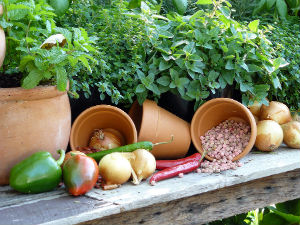
Story & Photos: Eion & Ann Scarrow
With soil still warm and moist from summer, autumn is the perfect time to grow a veggie garden.
First, you should plan to grow your vegetables in the sunniest part of your garden — sun and plenty of it is the most important part of growing healthy vegies.
As a rule of thumb for first-time gardeners, you should make your vegetable patch at least 3m x 2m. As you gain experience, you can add to it.
We have used ground treated timber 250mm high and 50mm thick for the border. However, you can use old building bricks/pavers set on an edge. Remember to place in a north to south alignment.
Following these steps will ensure a successful veggie garden:
1. Fork over the soil removing nasty perennial weeds such as dock, paspalum and couch.
2. Add compost to your soil — at least to the level of your edging.
3. Add dolomite lime 30g per square metre.
4. Dig out a trench 50-60cm deep and about 30cm wide. Add some sheep pellets — 2-3 handfuls per each lineal metre. Blood and bone 30g per lineal metre. Lightly fork this in and water the trench to start the process of breaking down the pellets.
5. Rake back the soil over the trench. Stretch a line across the bed and ease each plant out of its pot or punnet. Remember to hold young plants by their leaves, not their stem, as the stem is still tender and can be damaged.
6. After planting, water.
7. Mound up the soil around the plants by using a draw or Dutch hoe, as you do for spuds.
8. Now the ground work has been done, it’s time to think about what vegetables to grow in your garden. With winter on its way, consider savoy cabbage (the crinkly-leafed one), brussels sprouts, cauliflower, broccoli, silver beet and lettuce. Note that lettuce has a rosette pattern to its leaves and if planted too deeply the soil can cause the young plants to rot. In regards to what seeds to sow consider carrot, parsnip, radish, beetroot, green peas and broad beans. For a herb garden consider parsley, chives, garlic chives sage, thyme and rosemary.
Once you’ve finished planting, remember to water your new vegetables and herbs. Follow this procedure every 14 days until harvest.
Sowing seed for the autumn is best done when the soil is reasonably dry. We start with the same procedure as for planting the vegies. Rake over the area then put down your line. Then, with a stick, draw a line alongside the string and sow your seeds into this.
How deep do you sow? The rule of thumb is twice as deep as the size of the seed. Gently rake the soil back over the seed and lightly tamp the soil with the rake head held flat.
Remember, gardening is fun if done well.




